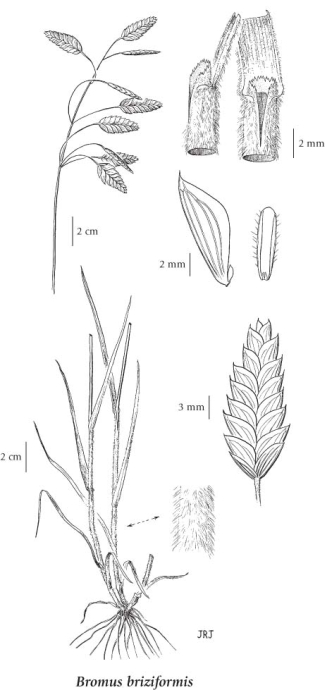Bromus briziformis Fisch. & C.A. Mey.
rattlesnake grass (rattlesnake brome; rattlesnake chess)
Poaceae (Grass family)
Introduction to Vascular Plants
rattlesnake grass (rattlesnake brome; rattlesnake chess)
Poaceae (Grass family)
Introduction to Vascular Plants
Species Information
General:
Annual grass from fibrous roots; stems densely hairy at the bases, 20-60 cm tall.
Leaves:
Sheaths usually open for 1-2 cm, densely soft-hairy; blades 2-5 mm wide, flat or slightly in-rolled, soft-hairy to short-hairy; ear-shaped lobes lacking at the leaf-bases; ligules hairy, eroded, 0.5-1.5 mm long.
Flowers:
Inflorescence a panicle, 4-12 cm long, with the branches and flowers more or less all to one side of the axis, the branches slender, lax, usually curved to reflexed, mostly bearing solitary spikelets; spikelets 9- to 15-flowered, compressed, cylindrical to egg-shaped, smooth, 15-30 mm long, 8-12 mm wide; florets mostly small, closed, self-fertilized; glumes lanceolate, the lower ones 3- to 5-nerved, 4-6 mm long, the upper ones (5-) 7- to 9-nerved, 7-9 mm long; lemmas inflated, 9-11 mm long, 2.8-4 mm wide, rounded at the tips, unawned, or with awn tips scarcely over 1 mm long; paleas 1-3 mm shorter than the lemmas; anthers, rarely exserted, about 0.8 mm long.
Illustration

If more than one illustration is available for a species (e.g., separate illustrations were provided for two subspecies) then links to the separate images will be provided below. Note that individual subspecies or varietal illustrations are not always available.
Illustration Source: The Illustrated Flora of British Columbia
USDA Species Characteristics
Flower Colour:
Yellow
Blooming Period:
Late Spring
Fruit/Seed characteristics:
Colour: Brown
Present from Spring to Summer
Source: The USDA
Ecology
Ecological Framework for Bromus briziformis
The table below shows the species-specific information calculated from
original data (BEC database) provided by the BC Ministry of Forests and Range.
(Updated August, 2013)
The table below shows the species-specific information calculated from
original data (BEC database) provided by the BC Ministry of Forests and Range.
(Updated August, 2013)
| Site Information |
Value / Class |
||
|
Avg |
Min |
Max |
|
| Elevation
(metres) |
709 | 502 | 1000 |
| Slope
Gradient (%) |
31 | 5 | 46 |
|
Aspect (degrees) |
199 | 98 | 256 |
| Soil
Moisture Regime (SMR) [0 - very xeric; 4 - mesic; 8 - hydric] |
2 | 1 | 4 |
| Modal
Nutrient Regime
Class |
C | ||
| #
of field plots species was recorded in: |
8 | ||
| Modal
BEC Zone Class |
PP | ||
|
All BEC Zones (# of stations/zone) species was recorded in |
ICH(1), IDF(2), PP(4) | ||
|
Source:
Klinkenberg 2013
|
|||
Habitat and Range
Dry meadows, roadsides and waste places; rare in SE BC; introduced from Eurasia.Status Information
Synonyms
Synonyms and Alternate Names:
Bromus brizaeformis Fischer & C. Meyer [orthographic variant]